Fujifilm Manager Talks X-T4 and More: “We Want to Continue Fujifilm X-H Line. Fujifilm X-T3 Firmware Update under Consideration”

Mapcamera interviewed one of Japanese top managers Mr. Takashi Ueno. They talk about Fujifilm X-T4.
The interview is quite long and in Japanese, so for your convenience I have summed it up all in English down below.
And just in case it was needed, he confirms that there will be a Fujifilm X-H2, as FujiRumors always told you and never doubted for a second, even when the whole universe was saying differently.
In fact, I tell you this: at no point in time, Fujifilm ever considered stopping the X-H line. The line they canceled is another one, and we told you here.
The only thing: the Fujifilm X-H2 is still very far away.
Trust me guys… I know what I talk about, and if you want to be the first to know and be guided accurately through the Fujifilm world, all you need to do is to follow FujiRumors.
In fact, I am working on further explosive rumors. Some will totally surprise you, others will probably disappoint you. When time has come, when things are double checked, when green light is given, you will get it all!
And now… the interview.
Join FujiRumors on Patreon, Facebook, Flipboard, Youtube, Instagram, RSS-feed and Twitter
- Fujifilm X-T4: BHphoto / AmazonUS / Adorama / FocusCamera
Fujifilm Manager Interview
MapCamera: Fujifilm X100V Top Seller, Great X-E3/X-H1/X-Pro3 Sales and APS-C Dominates Full Frame

Just yesterday here we reported how, according to BCN ranking, Fujifilm saw, in March, a huge 115% increase in sales in Japan, while all other camera manufacturers dropped up to 50%.
Now Japanese store MapCameras published their top selling camera rankings.
Keep in mind, though, that this is not representative for overall sales.
The most reliable data we probably have about the worldwide success of various camera brands, is this report from a Techno System Reports, a major marketing research company located in Japan that sells this data at a very high price, but somehow it went public at the Japanese site toyokeizai, and FujiRumors spotted it for you and shared it here.
The data of Techno System Reports reflects the mirrorless camera sales, and it shows that Fujifilm is on the third position, just a tiny margin behind Canon, and substantially behind Sony.
With that said, if big retailers share their sales data, it might not be representative for the overall market, but it can still give an approximate indication of what the market wants.
With that said, here are the top sellers at MapCameras for March 2020.
SALES RANKING
DPReviewTV: Fujifilm ACROS II Film Review vs. ACROS Film Simulation
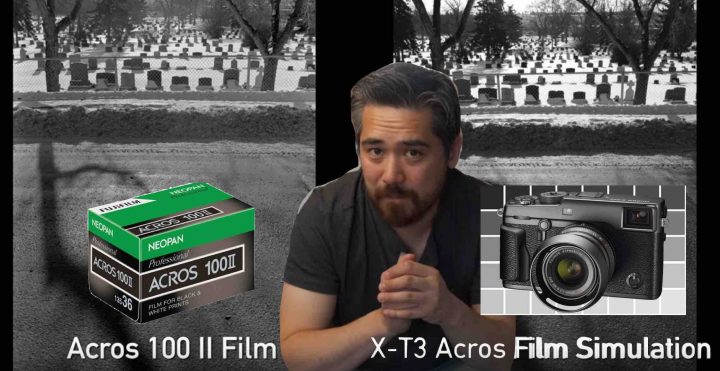
DPReview TV tested the new Fujifilm Acros II film, and compared it also with the much loved Acros film simulation we find on our Fujifilm X and GFX series cameras.
You can see the video below. Here are their findings summed up.
BCN Sales Ranking: Fujifilm Grows 115% and Sony, Canon & Co Fall 30% to 50%
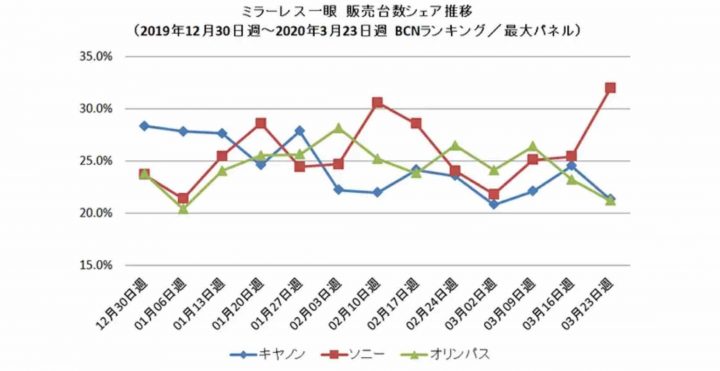
The latest BCN ranking has just been published. It collects data of about 40% of the Japanese electronics and online stores. Here is what they see:
- in March, camera sales were down 49.5% compared to March last year
- Sony dropped to 44.5%, Olympus to 54.9%, and Canon to 32.3%
- Only Fujifilm grew 115.6%. It has the fourth largest market share
They write:
In the rankings by series, Canon’s “EOS Kiss M” beat the Olympus “OLYMPUS PEN E-PL9” by a small margin to gain the top position. Sony ranks No. 1 by manufacturer and ranks No. 3 at “α6400”. As for Fujifilm’s soaring rise, “FUJIFILM X-A5” ranked 6th, and “FUJIFILM X-E3” ranked 9th. (Daisuke Okura, BCN)
Nice to see the Fujifilm X-E3 doing well. And hence even more disappointing that Fujifilm decided to axe it!
Also, keep in mind that in the last 6 months Fujifilm was extremely busy and launched lots of cameras, from the X-Pro3 to the X-T200, X100V and ultimately the X-T4 (the latter one not included in the raking, though). All this, while other manufacturer were not nearly as active.
And yet, nice to see this sales performance boost. It’s well deserved for a camera company, that makes some of the most inspiring photographic tools out there.
Rumors and Discussions
- Fujifilm GFX User Group
- Fujifilm X-T User Group
- Fujifilm X-H User Group
- Fujifilm X-E User Group
- Fujifilm X-Pro User Group
- Fujifilm X100 line Group
Stay in the Loop
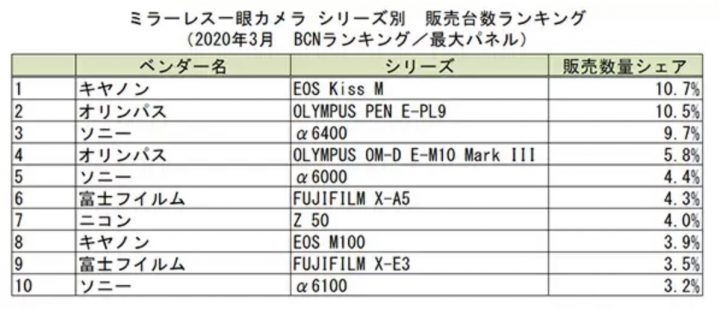
Fujifilm USA Manager: “Fujifilm X-T4: Lots of Pre-Orders and Available Mid-May”
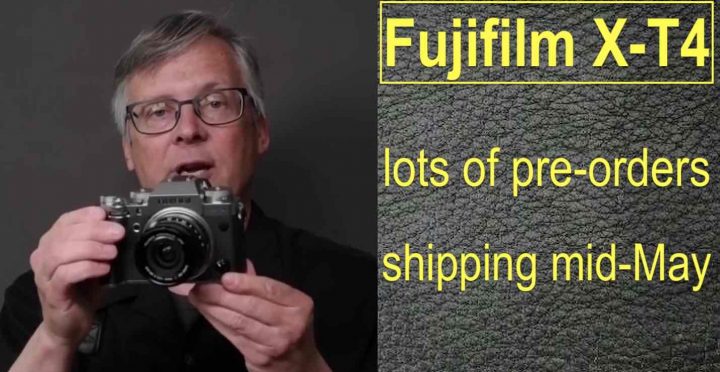
Fujifilm USA manager Michael Bulbenko made a 10 minutes video on Instagram introducing the Fujifilm X-T4.
Just as the top Manager Toshi Iida said a few days ago in this must see interview, also Michael confirms the strong pre-orders for the Fujifilm X-T4.
But strong pre-orders in times of Coronavirus COVID-19 also introduce shipping difficulties.
Regarding the shipping, I must say I am confused. Let’s sum up the different official statements we got so far in chronological order.
- March 26: Fujifilm Japan issues a press release, saying that the black X-T4 will ship as expected in late April, but the silver one has been postponed to late May
- April 2: Fujifilm UK manager says that both colors, silver and black will ship in late April, but body only version. The kit versions will follow “weeks later”
- April 9: Fujifilm USA manager says that nothing will ship in April, and all will ship in the 2nd or 3rd week of May
Maybe every country will get a different shipping time? That would be unusual for Fujifilm, but in these days everything is unusual.
If we look at stores, BHphoto marks it as available April 30, while Adorama expects it on May 4.
You can see the Manager video and a summary down below.
- Fujifilm X-T4: BHphoto / AmazonUS / Adorama / FocusCamera
Fujifilm X-T4 Manager Video
Fujifilm Photography in Times of COVID-19 Quarantine, the FujiRumors Lockdown Diary and the Revival of the XF 55-200
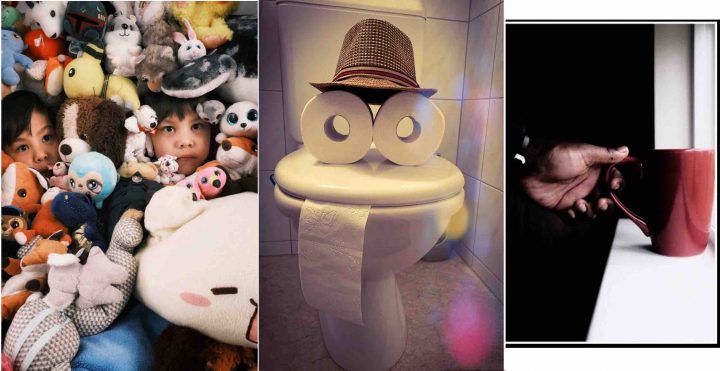
I read somewhere, that about 4 billion people are forced to stay at home now to slow down and hopefully stop the spread of the COVID-19 Coronavirus.
In my country, the stunning Dolomites in Italy, we are locked in since over 1 month now. Of course I strictly follow the rules and never leave my apartment, except to buy food 1 or 2 times a week, and to quickly bring out my old dog in the fields just under my home.
Teaching Online
I continue to teach. Just online! With live streaming lessons, videos I upload on youtube [does this qualify me as a vlogger now??? ;) ], material I send to students via email and more. I try to do my best.
But the more I do it, the more I miss it to enter a classroom, write on a blackboard, smell the chalk, but most importantly, interact with my students.
But hey, these days there are people, who live far bigger challenges than me. So no complaint here. Just a wish that everything goes back to normal soon.
Lockdown Photography
The first weeks all went into figuring out how to do this online teaching. Trying different platforms for online live lessons, adapt my material to make it online teaching fit, figure out how to reach the various students best (some have only a smartphone, no computer, no printer, etc), and more practical issues to sort out.
But now that I have some sort of workflow, I can start thinking at my lockdown photography.
In my small rented apartment, I am running out of subjects rather quickly.
- my cat is visibly annoyed by me taking all these picture of her with my new Fujinon XF56mm f/1.2.
- my trusty dog is 15+ years old, and sleeps almost all day. Too little action here
- my lovely wife does not want to pose for some boudoir photography (yet)… I need to convince her, but I won’t make impossible promises like “I won’t buy new gear this year, if you pose for me” :)
What I did now, is I started to take out my Fujinon XF55-200 lens, a lens I hardly use anymore since I own the Fujinon XF18-135mm (which never stops to surprise me, as you can see here).
The goal?
Get a decent shot of the little birds flying around my balcony, and the XF55-200 is the best lens in my arsenal for that. So it gets its revival now!
So far I have failed, though, not for the limits of the gear, but because of my lack of skills. But I have time to practice, improve, and I will upload an image on my instagram if I get a decent shot.
Inspiration
Another thing I like to do, is to check out all our facebook groups, and see how other fellow Fujifilm X and GFX shooters deal with these lockdown days and what they shoot.
I have picked out some images and shared them below. May them motivate you (and me) to stand up, and do the best out of this situation, also photographically speaking.
COVID-19 Image Roundup
Fujifilm Drug Avigan (Favipiravir) For COVID-19 (Coronavirus) Treatment Tested Worldwide (USA included) and Offered for Free to 20 Countries

Last month we reported how Zhang Xinmin, director of the science ministry’s China National Center for Biotechnology Development, said that the Fujifilm produced drug Avigan “has a high degree of safety and is clearly effective in treatment” and how a Japanese health ministry source suggested the drug was not as effective in people with more severe symptom.
A few days later, Fujifilm published another official statement, where they announce the start of phase III clinical trial of “Avigan” on COVID-19 Coronavirus and the commitment to increase production.
Avigan is currently tested all over the world, including here in Italy, where I live. But also in USA and many other countries.
Moreover, Japan plans to provide the anti-flu drug Avigan for free to 20 countries hoping to use it to treat coronavirus patients, Foreign Minister Toshimitsu Motegi said Tuesday.
As a consequence, Fujifilm ramped up production of flu drug Avigan as possible COVID-19 treatment.
Fujifilm or not, let’s hope some cure comes up soon, or this unreal situation will keep up for a long time.
Our Owners Groups
- Fujifilm GFX User Group
- Fujifilm X-T User Group
- Fujifilm X-H User Group
- Fujifilm X-E User Group
- Fujifilm X-Pro User Group
- Fujifilm X100 line Group
Our Facebook Pages
via japantimes via fiercepharma via nypost
Viltrox 33mm f/1.4 Official Product Page Online
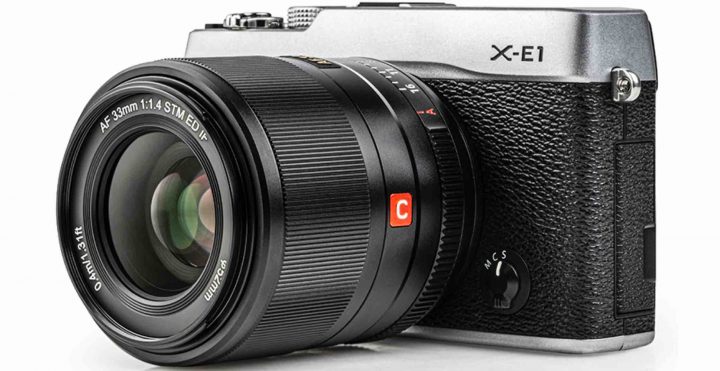
As we told you, Viltrox started taking pre-orders on the Viltrox 33mm f/1.4 AF lens.
They have also the product page up on their website since 1 week now, but apparently some missed it, so I share it now with all of you.
You can see the core specs of the lens as well as product images below.
The lens is available only in China for now, but I expect BHphoto & Co to get samples soon.
The other two Viltrox lenses, the Viltrox 23mm f/1.4 and the Viltrox 56mm f/1.4, should follow later on.
- Viltrox 33mm f/1.4 AF: BHphoto, AmazonUS, Adorama, eBay
- Viltrox 85mm f/1.8 AF: BHphoto, AmazonUS, Adorama
Viltrox 33mm f/1.4 AF
Game Over for Fujifilm X-E4, Fujinon XF 70-300mm, Tokina X Mount Lenses, New X-T3 Firmware, XF300 and XF500 Rumors & more Top March Articles
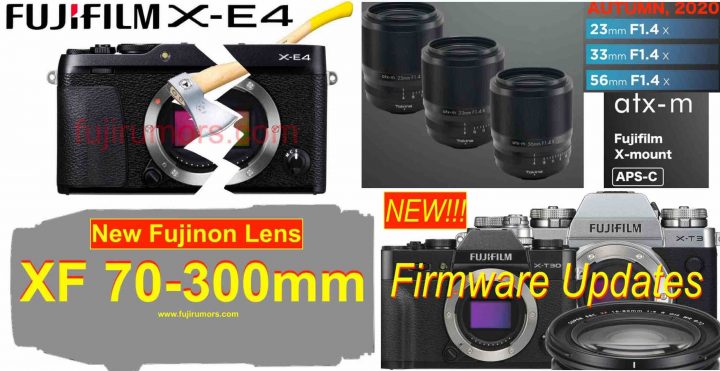
Here are the top 10 articles for March, which include a couple of breaking FujiRumors rumors.
As you can see, we never stop. So definitely stay tuned for more good stuff on FujiRumors.com.
- RUMOR: Fujifilm X-E line Canceled, Game Over for Fujifilm X-E4
- Fujifilm X-T4 vs Sony A7III vs Nikon Z6 IBIS and Video Quality Comparison by Max Yuryev
- Fujifilm X-T2 Firmware 4.32 Released
- New Firmware for Fujifilm X-T3, X-T30 and XF 16-80mm f/4 Released
- This PDF Lists 80 Fujifilm Film Simulation Custom Profiles You Can Try out Yourself
- Tokina to Launch Three Fujifilm X Mount Lenses in 2020
- EXCLUSIVE: Fujifilm Working on Fujinon XF 70-300mm X Mount Lens
- The Big Lens Roundup: Fujinon Lenses, Third Party Glass, Autofocus Adapter and More
- Fujifilm Manager: “The Fujifilm X-T4 is Bashing the Door Down Hard on Sony A7III users”, X-H2 and More
- Fujifilm XF 300mm F4 and 500mm F5.6 Patents Found
FujiRumors is on Patreon, Facebook, Instagram, RSS-feed, Youtube, Flipboard and Twitter
Our Owners Groups
- Fujifilm GFX User Group
- Fujifilm X-T User Group
- Fujifilm X-H User Group
- Fujifilm X-E User Group
- Fujifilm X-Pro User Group
- Fujifilm X100 line Group
Our Facebook Pages

